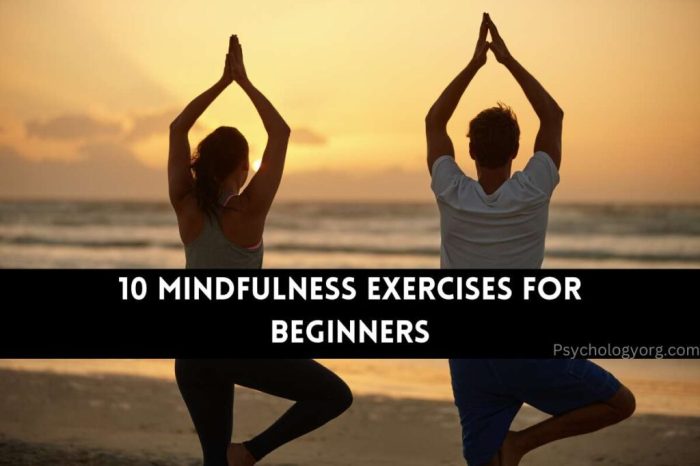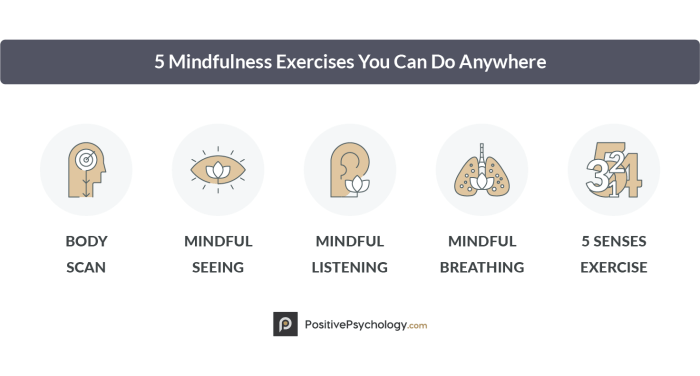Mindfulness Exercises, a powerful tool for enhancing mental well-being, offer a gateway to inner peace and clarity. Dive into the realm of mindfulness and discover a transformative journey towards self-awareness and tranquility.
Introduction to Mindfulness Exercises
Hey, so you wanna know about mindfulness exercises, huh? Well, let me break it down for you. Mindfulness exercises are all about being present in the moment, fully aware of your thoughts, feelings, and surroundings. The purpose? To help you reduce stress, improve focus, and increase overall well-being.
Now, let’s talk about the benefits of practicing mindfulness exercises. First off, it can help you manage anxiety and depression by training your mind to stay calm and focused. It also improves your emotional regulation, making it easier to handle difficult situations. And hey, it even boosts your immune system and enhances your overall mental health. Pretty cool, right?
Real-life Impact of Mindfulness Exercises
- One study found that mindfulness meditation helped reduce symptoms of post-traumatic stress disorder (PTSD) in veterans.
- Athletes who practice mindfulness exercises have reported better performance and increased resilience in the face of challenges.
- Students who incorporate mindfulness practices into their daily routine have shown improved concentration and academic performance.
Types of Mindfulness Exercises
There are various types of mindfulness exercises that can help in cultivating mindfulness and promoting overall well-being.
Mindful Breathing
Mindful breathing involves focusing your attention on the sensation of your breath as it enters and leaves your body. This exercise can help you stay present in the moment and calm your mind.
- Find a quiet place to sit or lie down comfortably.
- Close your eyes and take a few deep breaths to center yourself.
- Focus on the natural rhythm of your breathing, noticing the inhales and exhales.
- When your mind starts to wander, gently bring your focus back to your breath without judgment.
- Continue this practice for a few minutes or as long as you feel comfortable.
Body Scan
The body scan exercise involves systematically focusing your attention on different parts of your body, from head to toe. This can help you become more aware of physical sensations and release tension.
- Lie down in a comfortable position and close your eyes.
- Start by bringing your attention to your toes, noticing any sensations or feelings in that area.
- Slowly move your focus up through each part of your body, paying attention to any tension or discomfort.
- Take deep breaths and try to relax each body part as you scan through it.
- Finish by bringing your awareness back to your body as a whole and feeling a sense of relaxation.
Loving-Kindness Meditation
Loving-kindness meditation involves directing positive thoughts and feelings towards yourself and others. This practice can help cultivate compassion, empathy, and connection with others.
- Sit in a comfortable position and close your eyes.
- Begin by focusing on sending loving-kindness to yourself, repeating phrases like “May I be happy, may I be healthy, may I be at peace.”
- Next, extend this loving-kindness to someone you care about, then gradually to neutral people and even those you may have difficulties with.
- Feel the warmth and compassion in your heart as you cultivate feelings of love and kindness towards all beings.
- Finish by taking a few deep breaths and slowly opening your eyes, carrying this sense of loving-kindness with you throughout the day.
Mindfulness Exercises for Stress Reduction

When it comes to reducing stress, mindfulness exercises can be incredibly effective in helping individuals manage and cope with the daily pressures of life. By practicing mindfulness, individuals can learn to focus on the present moment, cultivate self-awareness, and develop a sense of inner calm.
Deep Breathing Exercises
- One effective mindfulness exercise for stress reduction is deep breathing. This involves taking slow, deep breaths in through the nose, holding for a few seconds, and then exhaling slowly through the mouth. Deep breathing can help calm the nervous system and reduce feelings of anxiety and tension.
Body Scan Meditation
- Body scan meditation is another mindfulness exercise that can be helpful in reducing stress. This practice involves systematically focusing on each part of the body, starting from the toes and working your way up to the head. By paying attention to physical sensations without judgment, individuals can release tension and promote relaxation.
Mindful Walking, Mindfulness Exercises
- Engaging in mindful walking is a great way to reduce stress and increase mindfulness. By focusing on each step, the sensations in the feet, and the surrounding environment, individuals can bring their awareness to the present moment and let go of worries and stressors.
By incorporating these mindfulness exercises into their daily routine, individuals can experience a significant reduction in stress levels and an overall improvement in their well-being. Many people have found relief from stress through the consistent practice of mindfulness, leading to a greater sense of peace and balance in their lives.
Incorporating Mindfulness into Daily Routine

It’s essential to find ways to seamlessly integrate mindfulness exercises into your daily life to reap the full benefits of this practice. Consistency is key when it comes to cultivating mindfulness, and overcoming common barriers can help you stay on track.
Tips for Incorporating Mindfulness into Daily Routine
- Start small: Begin by setting aside just a few minutes each day for mindfulness activities, such as deep breathing or body scans.
- Set reminders: Use alarms or notifications on your phone to prompt you to take mindfulness breaks throughout the day.
- Combine activities: Incorporate mindfulness into daily tasks like washing dishes or taking a shower by focusing on the sensations and movements involved.
- Practice gratitude: Take a moment each day to reflect on things you are grateful for, fostering a positive mindset.
Importance of Consistency in Mindfulness Practice
Consistency is crucial in mindfulness practice as it helps you build a routine and develop a habit. Regular practice allows you to deepen your mindfulness skills and experience more profound benefits over time.
Strategies for Overcoming Barriers to Integrating Mindfulness
- Acknowledge resistance: Recognize any internal resistance to practicing mindfulness and work on addressing these thoughts or feelings.
- Adapt to your schedule: Find moments in your day where you can fit in mindfulness exercises, even if it means adjusting your routine slightly.
- Be patient with yourself: Understand that incorporating mindfulness takes time and effort, and be kind to yourself throughout the process.
- Join a community: Consider joining a mindfulness group or class to stay motivated and accountable in your practice.